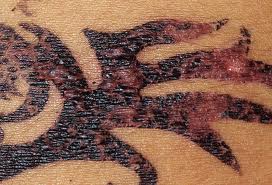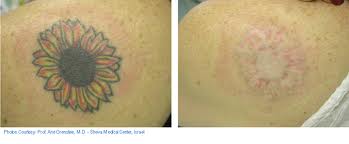
Though the younger generations of our modern times (those around the age of 35 and younger) would strongly argue that body art and tattoos are a popular trend and well accepted style to sport on the surfaces of the skin, there are definite more traditional, religious and conservative minds that frown at the thought of anything creating permanent marks on the body. As what some would say is “becoming a fast mark of the 21st century” and “more than 30 percent of people under the age of 30 has one permanent body art tattooed onto the skin,” it is no wonder personal expression and free spirits can be confused with rebellious youth of new generations gone awry.
From a scientific stand point, there are some risks associated to permanent tattoos. The Mayo Clinic describes tattoos as a “permanent mark or design made on your skin with pigments inserted through pricks into the skin's top layer.” In most instances, tattoo artists use hand-held machines that act like a sewing machine (with one or more needles piercing the skin repeatedly). With every puncture, the needles insert tiny ink droplets. The process — which is done without anesthetics — causes a small amount of bleeding and slight to potentially significant pain.”
Okay, so there is some pain. Medically speaking, however, some risks may affect the health of the person getting tattooed. These, according to Health US News include:
Tattoo dyes — especially red, green, yellow and blue dyes — can cause allergic skin reactions, such as an itchy rash at the tattoo site. This can occur even years after you get the tattoo.
A skin infection — which might cause redness, swelling, pain and a pus-like drainage — is possible after tattooing.
Sometimes bumps called granulomas form around tattoo ink. Tattooing can also lead to keloids—raised areas caused by an overgrowth of scar tissue.
If the equipment used to create your tattoo is contaminated with infected blood, people can contract various bloodborne diseases — including tetanus, hepatitis B and hepatitis C and even HIV (transmitted through the use of non-sterile tattoo needles).
Rarely, tattoos or permanent makeup might cause swelling or burning in the affected areas during magnetic resonance imaging (MRI) exams. In some cases, tattoo pigments can interfere with the quality of the image — such as when a person who has permanent eyeliner has an MRI of the eye.
This includes possible removal of the tattoo (discussed later in the article) — might be needed if you experience an allergic reaction to the tattoo ink or you develop an infection or other skin problem near a tattoo.
Despite what the Center for Disease Control (CDC) warns about tattoos being dangerous for the public’s health, the overwhelming support given by body art lovers worldwide seem to disagree. One passionate tattoo artist offers a history lesson in her argument pro-tattooing. “Tattooing is one of the oldest traditions on this planet and has been around for more than 10,000 years; It is not a trend. It is not unhealthy or unclean or bad for the body unless the tattooed individual fails to take care of the area correctly.” Organic and natural inks are available now for the earthy and conscious individuals, and if green are the way you choose to paint, there are organic plant matter, water, glycerin, and ethyl alcohol inks, though not all parlors may carry them. It is good to do more research on places that are rated well, clean, keeps their equipment and work environment sterile.
But does the CDC have some kind of right to take a negative stance of tattoos after a cluster of skin infections popped up in New York (which led back to one tattoo artist and artist’s hygiene practices)? The health officials found that the tattoo artist’s practices were all sanitary, but the nationally distributed and used ink on the patrons was tainted. There were very similar cases in Colorado, Washington and Iowa, where harmful strands of bacteria were found present in contaminated ink. I think the CDC did a good job in finding the sources of contamination, and such infections (mycobacterium infections) likely arose from the use of unsterile water as a diluting agent in ink. Because the ink that caused the New York outbreak was "gray wash," pre-diluted black ink used for shading, the CDC has speculated that its manufacturer may not have been using sterile water.
Sadly, even with good investigation by a patron’s part, there is no way to be 100% sure that a given manufacturer's tattoo ink is sterile, because like the vast majority of natural herbs and supplements and its true quality, currently, there are no FDA regulations requiring that tattoo inks be sterile. This means that a consumer has to trust a company's or an artist's word on that one. It is also worth noting that although a number of the color pigments used in tattoo ink have been approved by the FDA for use in cosmetics, not a single one has ever been approved for injection into the skin (Natural News.com)
People who love body art, respect it for spiritual purposes, such as henna tattoos, can get the feel of a permanent ink through a temporary tattoo. Done by either a decal that is transferred to the skin or a henna tattoo (body art called mehndi), it is much safer as far as infections and skin scarring risks and hennas uses a plant-based ink called henna, which is painted onto the skin. It is good to note that the natural color of henna is orange or brown and artificial chemicals are added to make different colors such as black or blue.
For children who love to adorn their little arms and bellies with their favorite Disney or superhero character temporary tattoo, parents should be aware that any of the temporary tattoos that contain p-Phenylenediamine, also called coal tar or PPD, as has been known to cause an allergic reaction in some people, so check skin reactions after application.
There is a ban on temporary tattoos that don't declare their ingredients on the label, so they are not allowed into the United States. But the FDA can't regulate all temporary inks used commercially by professionals, so there's no guarantee that the temporary tattoo you're getting is safe (Mayo Clinic).
Yes, tattoos may hurt, are permanent, and people may end up with a faded or wrinkly little butterfly on their shoulder or lower back for the rest of their life, but modern technology has allowed people to get a close second chance with body free art—well, almost. Tattoo laser removal comes with its list (albeit small) of precautions as well. Before we list those risks, it is good to note that not all tattoos can be removed. Some colors of ink may remain even after treatment with lasers.
It is reported by the University of Arkansas for Medical Sciences that 50 % people who get tattoos later regret the action. Though tattoos are designed to be permanent, and removal can be difficult, people have the choice now to have the tattoo cut out (excised), rubbed out with dermabrasion or erased with a laser. With most laser procedures, more than one session may be in order.
According to the University of Iowa Hospitals and Clinics and Cosmetic Surgery.com, scarring (especially from dermabrasion carries a 1-2 percent risk). Infections, the greatest risk of tattoo removal with excision, can occur from not keeping the tattoo site clean and forgetting to apply antibiotic ointment.
Another possible risk is pigment change on the skin where the tattoo ink is removed. Skin may become patchy looking and discolored. Dermabrasion, which uses an abrasive substance to erase the tattoo, can also cause changes in skin pigment. A good note to take into consideration is that not all tattoos can be removed, even with the modern technology we have. Some colors of ink may remain even after treatment with lasers (Source: Livestrong.com).
I appreciate all forms of art and enjoy learning from people why they chose to tattoo certain fonts, pictures and graphics on their bodies. I used to really enjoy watching Ellen DeGeneres's "Bad Paid-For Tattoo" segment of her show, highlighting some of the funniest sent in pictures of real tattoos gone wrong. I think body arts mean different things in each culture and religion and is another powerful way to make a personal statement to the world. Though I am not much of a risk taker myself and have no tattoos of my own, I understand the choice to have them done, and if people want to do so, take a few extra steps to learn about the possible health and physical risks and choose a reputable and clean parlor with clean products.
